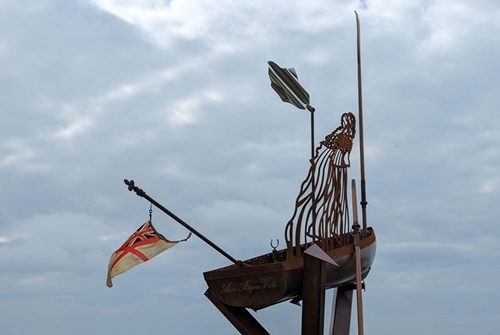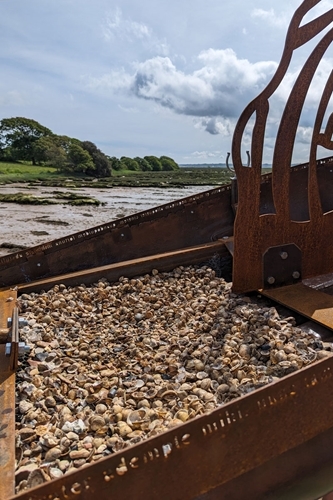 A new sculpture unveiled in honour of the women who played part in the preparations for D-Day will also help our rare and threatened wading and coastal birds find a safe nesting site.
A new sculpture unveiled in honour of the women who played part in the preparations for D-Day will also help our rare and threatened wading and coastal birds find a safe nesting site.
‘Our Lady of the South’ was designed and constructed in consultation with the Game & Wildlife Conservation Trust and has been positioned beside saltmarsh habitat along the eastern bank of the Beaulieu River on the Exbury Estate in the New Forest.
Depicting the figure of a woman waving a white handkerchief and a boat that was found washed up on the shore, it also serves as a raised shingle nesting platform, providing an ideal environment for oystercatchers, common terns and other species that typically nest on shingle along the shoreline, which makes them vulnerable to mammalian predators.
The Latin inscription around the edge of the dinghy, which ends with ‘Ave Atque Vale’, meaning ‘Hail and Farewell’, is often used for a final goodbye. A plaque explains that the sculpture is: “Dedicated to all those who went and did not return, and also those who came home”, and it marks the 80th anniversary of D-Day on 6 June 2024.

Another plaque next to the sculpture, which was created by renowned photographer Alastair Morrison and local sculptor Chris Campbell, says: “In consultation with the Game & Wildlife Conservation Trust, our sculpture ‘Our Lady of the South’ has an important secondary purpose. Alongside being a standing memorial to all those who embarked from the Beaulieu River and the Solent on their way to defeat the tyranny of the Nazis, it is also a newly designed nesting platform for our endangered riverine birdlife.
“The inside of the dinghy is specially prepared with a layer of beach shingle and old cockle shells, which is the ideal nesting environment for both oystercatchers and common terns, amongst other shingle lovers who visit to lay their eggs out of the reach of ground-dwelling egg-eaters such as foxes and badgers.”

Beach-nesting birds suffer ‘catastrophic losses’
‘Our Lady of the South’ sits across the river from the North Solent National Nature Reserve, where another GWCT project is under way to boost numbers of threatened beach-nesting birds like ringed plover, oystercatchers and terns, by creating new shingle habitats and trialling novel non-lethal predation management techniques to improve their breeding success.
Mike Short, who leads the Gravelly Shores project, which is funded through Natural England’s Species Recovery Programme, said: “We have been monitoring oystercatcher breeding attempts around the mouth of the Beaulieu River since 2022, and our nest cameras show catastrophic losses, with most beach-nesting attempts failing due to egg predation by foxes and hedgehogs. This year, we have constructed raised shingle nesting platforms in known oystercatcher breeding territories, to try and encourage them to nest out of reach of mammalian predators.
 “Oystercatchers are famous for nesting on man-made structures including rooftops, and shingle platforms could be a way of providing attractive and safer and nest sites. Our platforms are located immediately adjacent to saltmarsh and mud-flats, so chicks from successful nests hatch into optimal feeding habitats.
“Oystercatchers are famous for nesting on man-made structures including rooftops, and shingle platforms could be a way of providing attractive and safer and nest sites. Our platforms are located immediately adjacent to saltmarsh and mud-flats, so chicks from successful nests hatch into optimal feeding habitats.
“Since 1995, the UK’s breeding population of oystercatcher has declined by 22%. They urgently need our help, and Exbury’s conservation-minded landowner Nick de Rothschild has done just that by making ‘Our Lady of the South’ into the most exclusive shingle nesting platform along the south coast.”
The new sculpture will form part of an arts trail called ‘Time to Connect’ and will be a permanent art piece commemorating D-Day – the 6 June 1944 is seen as the major turning point of World War II, when Allied troops invaded Nazi-occupied France by landing around 326,000 troops on the beaches of Normandy.
More than 100 Wrens, the Women’s Royal Naval Service, were based at Exbury House in the lead up to D-Day, after it had been requisitioned by the Navy in 1942.
Alistair Morrison, who came up with the idea for the statue, said: “It represents the women that were left behind on our shores. Not just the Wrens, but also the families, the mums, the sisters, the daughters who were saying goodbye to very young men.”
‘Our Lady of the South’ acts as an important reminder of the past, whilst also making sure we don’t leave our vulnerable wading birds behind.
Notes to editors
The Game & Wildlife Conservation Trust – providing research-led conservation for a thriving countryside. The GWCT is an independent wildlife conservation charity which has carried out scientific research into Britain’s game and wildlife since the 1930s. We advise farmers and landowners on improving wildlife habitats. We employ more than 60 post-doctoral scientists and other research staff with expertise in areas such as birds, insects, mammals, farming, fish and statistics. We undertake our own research as well as projects funded by contract and grant-aid from government and private bodies.
For information, contact:
Eleanor Williams
Telephone: 07592 025476
Email: press@gwct.org.uk